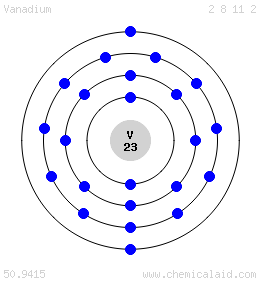Atomic number: 23
Atomic mass: 50.9
Valence electrons: +5, +4
Vanadium is a transition metal discovered by Mexican chemist Andres Manuel del Rio in 1801. His work was not accepted however, when French chemist Hippolyte-Victor Collet-Descotils stated that it was just impure chromium. The element was rediscovered in 1830 by Nils Gabriel Sefstrom from Sweden, and it was named Vanadium after the Scandinavian goddess of beauty, Vanadis. 85% of vanadium that is produced is used to make steel alloys. It’s commonly used to create parts for cars and jet engines, as well as gears and axles. A unique fact about vanadium is that it has four oxidation states and changes colour for each one. Here is a video showing the different states:
Sources:
- “Vanadium.” Chemicool Periodic Table. Chemicool.com. 18 Oct. 2012. Web. 9/22/2015 <http://www.chemicool.com/elements/vanadium.html>.
Images:
- http://www.chemicalaid.com/element.php?symbol=V
- http://www.slicktiger.co.za/2013/03/11/escape-monday-stunning-close-up-pics-of-element



